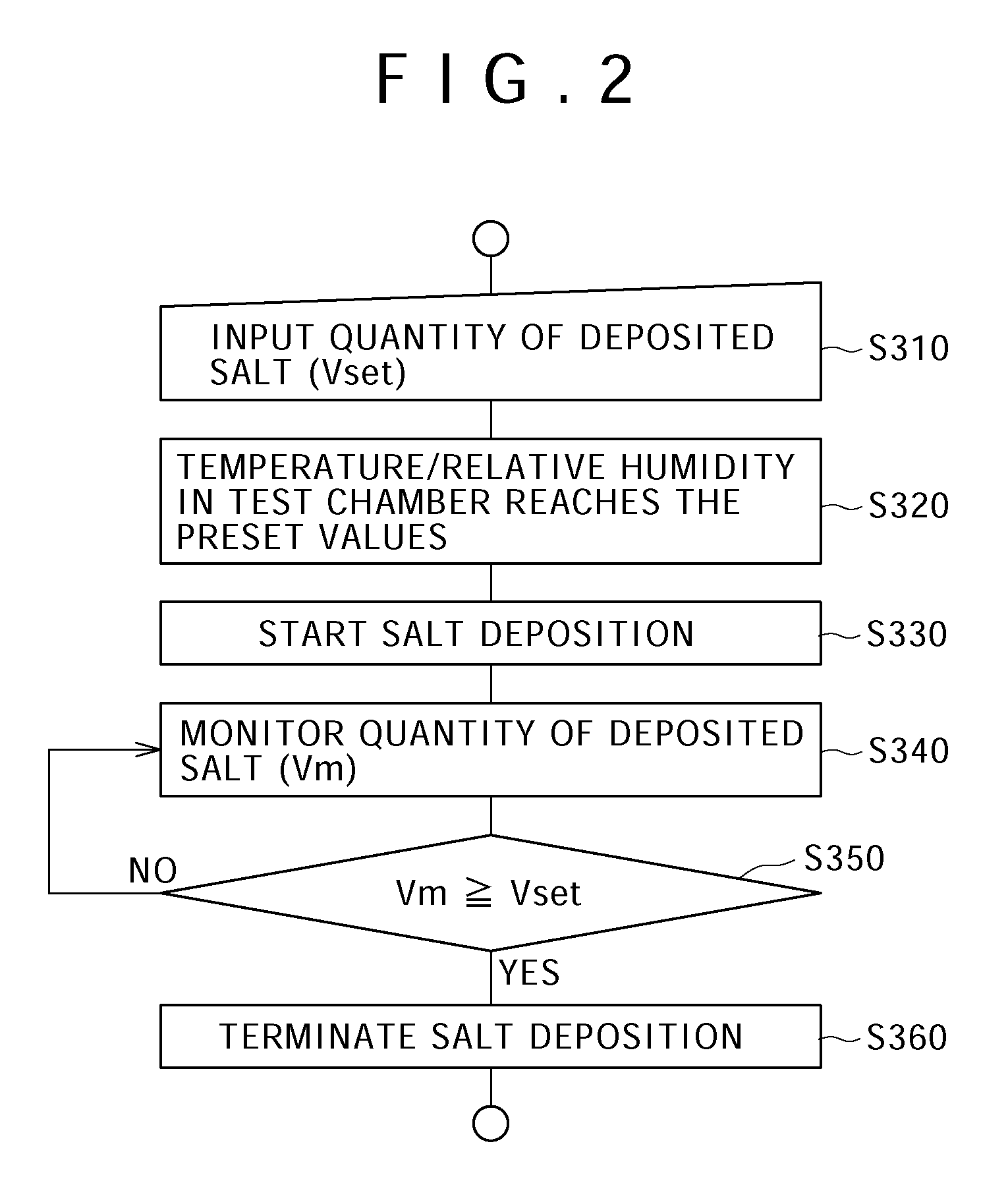Atmospheric corrosion test procedure and its apparatus
a technology of atmospheric corrosion and test procedures, applied in measurement devices, scientific instruments, instruments, etc., can solve the problems of not satisfactorily reproducing the corrosion caused, requiring a long time, and a large difference in the size of sea salt particles flying in the natural environment, so as to improve the test accuracy and the effect of variation in the quantity of salt conten
- Summary
- Abstract
- Description
- Claims
- Application Information
AI Technical Summary
Benefits of technology
Problems solved by technology
Method used
Image
Examples
first embodiment
[0038]FIG. 7 is a block diagram of an atmospheric corrosion test apparatus, which automatically carries out a series of steps of an atmospheric corrosion test procedure.
[0039]The atmospheric corrosion test apparatus 1 is composed of a thermo-humidistat chamber 110, a pump 115, a salt-water tank 120 (salt-water reservoir), a salt-water nozzle 125 (salt mist supplying unit), an exhaust unit 130, a rinsing water tank 140, a rinsing water nozzle 145, and a warm-air drying unit 150. Inside the thermo-humidistat chamber 110, a space is left for placing the test pieces 160. This figure shows the thermo-humidistat chamber 110 with the test piece 160 placed therein. The thermo-humidistat chamber 110 further has the salt-water nozzle 125, the rinsing water nozzle 145, and a warm-air drying unit 150 therein.
[0040]The thermo-humidistat chamber 110 also has a programming function capable of controlling independently the temperature and relative humidity therein and continuously varying among mor...
second embodiment
[0059]FIG. 9 is a block diagram of a semi-automatic apparatus carrying out the atmospheric corrosion test procedure, in which only the rinsing step is carried out manually and other steps are carried out automatically.
[0060]The atmospheric corrosion test apparatus 1 is composed of the thermo-humidistat chamber 110, the pump 115, the salt water tank 120 (salt water reservoir), the salt-water nozzle 125 (salt mist supplying unit), and the exhaust unit 130. The atmospheric corrosion test apparatus according to the second embodiment is different from the apparatus according to the first embodiment in that it does not include the rinsing water tank 140, the rinsing water nozzle 145, and the warm-air drying unit 150.
[0061]In this embodiment, an aluminum alloy sheet formed into the shape 70×70×3 mm was used for the test pieces 160.
[0062]Next, the atmospheric corrosion test procedure according to this embodiment will be described with reference to FIG. 8. The explanation described in the fi...
third embodiment
[0076]FIG. 1 is a block diagram of an apparatus automatically carrying out a series of steps of the atmospheric corrosion test procedure.
[0077]As known from this figure, the quantity (volume) of the salt mist supplied from the salt-water nozzle 125 is measured using an integrating flowmeter 170 (flow rate measuring unit) and closing an on-off valve 180 when the volume reaches a preset value to stop the spray of salt water. A rinsing water tank 140 and a warm-air drying unit 150 have been incorporated inside the thermo-humidistat chamber 110. This figure shows the apparatus according to this embodiment with test pieces 160 placed therein.
[0078]The explanation described in the first embodiment will be partially omitted and thereinafter, differences of the apparatus according to the third embodiment from the apparatus according to the first embodiment will be mainly described.
[0079]As with the first embodiment, the thermo-humidistat chamber 110 according to this embodiment is capable o...
PUM
| Property | Measurement | Unit |
|---|---|---|
| temperature | aaaaa | aaaaa |
| temperature | aaaaa | aaaaa |
| RH±3 | aaaaa | aaaaa |
Abstract
Description
Claims
Application Information
 Login to View More
Login to View More - R&D
- Intellectual Property
- Life Sciences
- Materials
- Tech Scout
- Unparalleled Data Quality
- Higher Quality Content
- 60% Fewer Hallucinations
Browse by: Latest US Patents, China's latest patents, Technical Efficacy Thesaurus, Application Domain, Technology Topic, Popular Technical Reports.
© 2025 PatSnap. All rights reserved.Legal|Privacy policy|Modern Slavery Act Transparency Statement|Sitemap|About US| Contact US: help@patsnap.com



